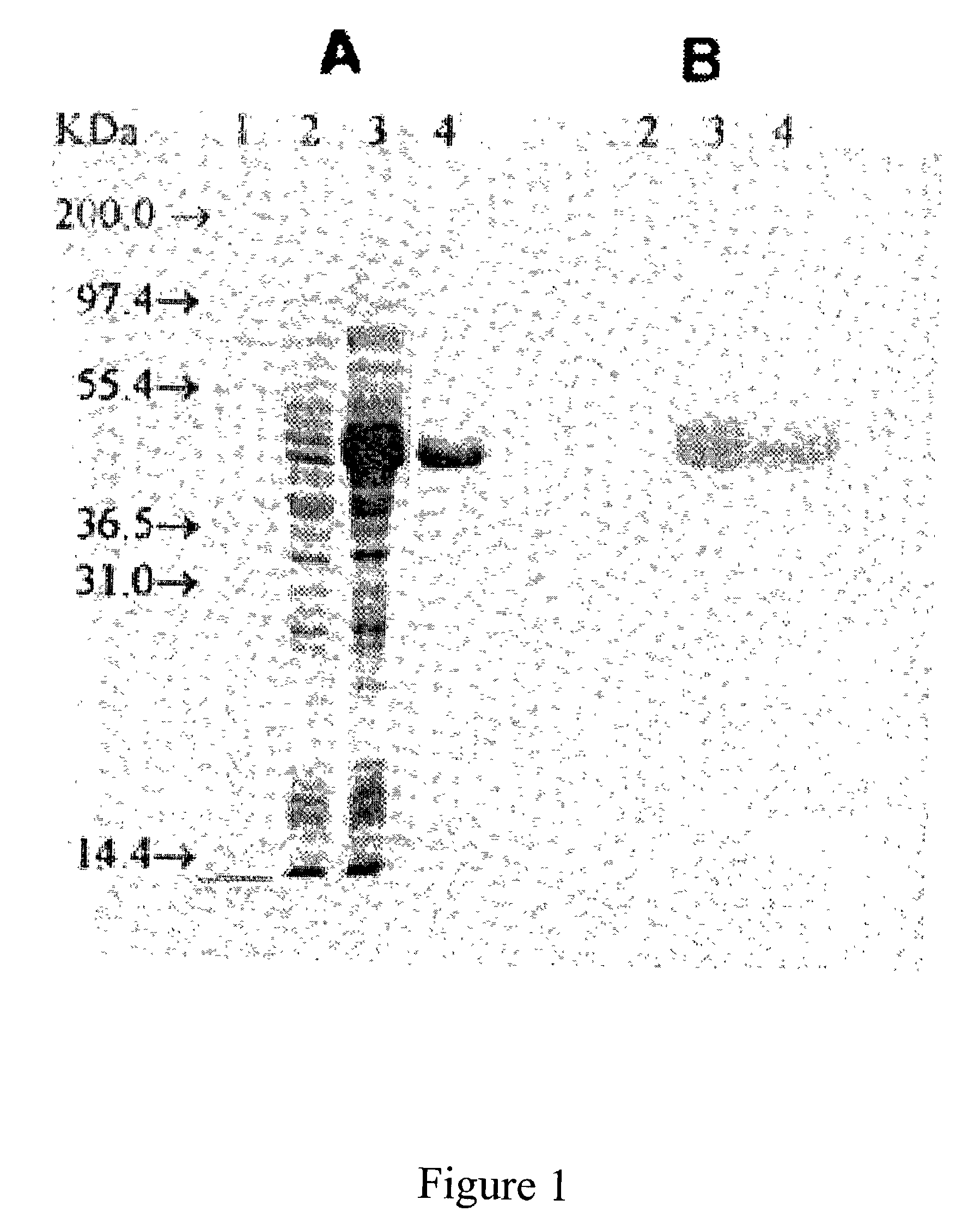Mutant-type lipases and applications thereof
a lipase and mutant technology, applied in the field of mutant-type lipases, can solve the problems of unreported structure-function studies, unfavorable food preparation, and high cost of natural esters, and achieve the effect of facilitating purification of mutant-type lipase and enhancing flavor in food
- Summary
- Abstract
- Description
- Claims
- Application Information
AI Technical Summary
Benefits of technology
Problems solved by technology
Method used
Image
Examples
example 1
Cloning of Lys-303 Gene From S. epidermidis Strain 9
[0028]A fragment of the gehC gene (designated “Lys-303” gene), which encoded an amino acid sequence corresponding to that of the S. epidermidis lipase following proteolytic cleavage between Ala-302 and Lys-303, was synthesized by polymerase chain reaction (PCR) using a chromosomal DNA from a S. epidermidis isolated from a patient in Chang-Gung Hospital (Keelung, Taiwan) as template. The gehC gene is a Staphylococcus epidermidis strain 9 lipase gene. The gene consisted of a single open reading frame of 2064 nucleotides, which encoded a protein of 688 amino acids with a predicted molecular mass of 77 kDa. The Lys-303 gene (SEQ ID NO:13) encoded an active lipase (SEQ ID NO:14), which was about 43 kDa in molecular weight. The Lys-303-encoded lipase is also known as the “43 kDa” or “wild-type” lipase. Two primers: an N-terminal primer of SEQ ID NO:1 (5′-GGGGCCATGGAACAAAAACAATATAAAAAT-3′) and a C-terminal primer of SEQ ID NO:2 (5′-GGGGCT...
example 2
Site-directed Mutagenesis
[0030]Mutant genes were synthesized from S. epidermidis chromosomal DNA by a two-step, three-primer PCR method in which the N-terminal and C-terminal oligonucleotides were identical to those used for the synthesis of the “Lys-303” gene (i.e., SEQ ID NO:1 and SEQ ID NO:2), as described in Example 1. The oligonucleotide primers for the mutation sites are listed in Table 1. The products of the PCR were digested with NcoI and XhoI, and were ligated to a NcoI / XhoI-predigested pET-20b(+) DNA fragment. The desired ligated products were cloned, first into E. coli HB101, then into E. coli BL21 (DE3). The DNA sequences surrounding mutant codons were determined (Sanger et al. 1977) from the plasmids isolated from E. coli BL21 (DE3).
[0031]
TABLE 1Oligonucleotides Used for the PCR-Site-DirectedMutagenesis of the S. epidermidis “Lys-303”Recombinant Lipase GeneaaPrimersSequence No.Oligonucleotideswild-SEQ ID NO:35′-GACCACCCATACTATGACCAAC-3′typeS418CSEQ ID NO:45′-ACCCATACAAT...
example 3
Expression of the Wild-type or Mutant-type Lipases
[0032]E. coli BL21 (DE3) cells harboring the desired wild-type lipase gene (i.e., the Lys-303 gene) on plasmid pET-20b(+), were grown at 30° C. in LB / ampicillin to an optical density (600 nm) of 0.5. IPTG was added to the cultures (100 mL each) for a final concentration of 4 mM, and the cells were harvested four hours after the IPTG induction. IPTG is β-D(−)-thiogalactopyranoside, which induces the expression of a recombinant gene.
PUM
| Property | Measurement | Unit |
|---|---|---|
| molecular mass | aaaaa | aaaaa |
| molecular weight | aaaaa | aaaaa |
| optical density | aaaaa | aaaaa |
Abstract
Description
Claims
Application Information
 Login to View More
Login to View More - R&D
- Intellectual Property
- Life Sciences
- Materials
- Tech Scout
- Unparalleled Data Quality
- Higher Quality Content
- 60% Fewer Hallucinations
Browse by: Latest US Patents, China's latest patents, Technical Efficacy Thesaurus, Application Domain, Technology Topic, Popular Technical Reports.
© 2025 PatSnap. All rights reserved.Legal|Privacy policy|Modern Slavery Act Transparency Statement|Sitemap|About US| Contact US: help@patsnap.com

